University Solar Tracker System Project: Electrical Engineering
VerifiedAdded on 2020/05/04
|14
|2845
|217
Project
AI Summary
This project report details the design and implementation of a solar tracker system aimed at increasing the efficiency of solar energy collection. The report begins with an executive summary emphasizing the importance of renewable energy and the limitations of fixed photovoltaic panels, introducing the concept of a solar tracker. The project includes a literature review, discussing the existing research on solar cells and tracking systems. Research questions are formulated, focusing on the use, advantages, challenges, and recommendations for the project. The project's aim is to develop a solar cell system that maximizes energy production by tracking the sun's position. Steps taken include constructing panels to capture solar energy, converting it into electricity using photovoltaic cells, and storing energy in batteries. The project utilizes LDR sensors to detect sunlight intensity and adjust the panel's position accordingly. The report details the experimental setup, including site evaluation, panel mounting, wiring, and connection to control panels and batteries. A Gantt chart outlines the project's timeline and resource allocation. The conclusion summarizes the project's findings, emphasizing the benefits of solar tracking systems and the importance of renewable energy sources. The report also includes a comprehensive list of references.
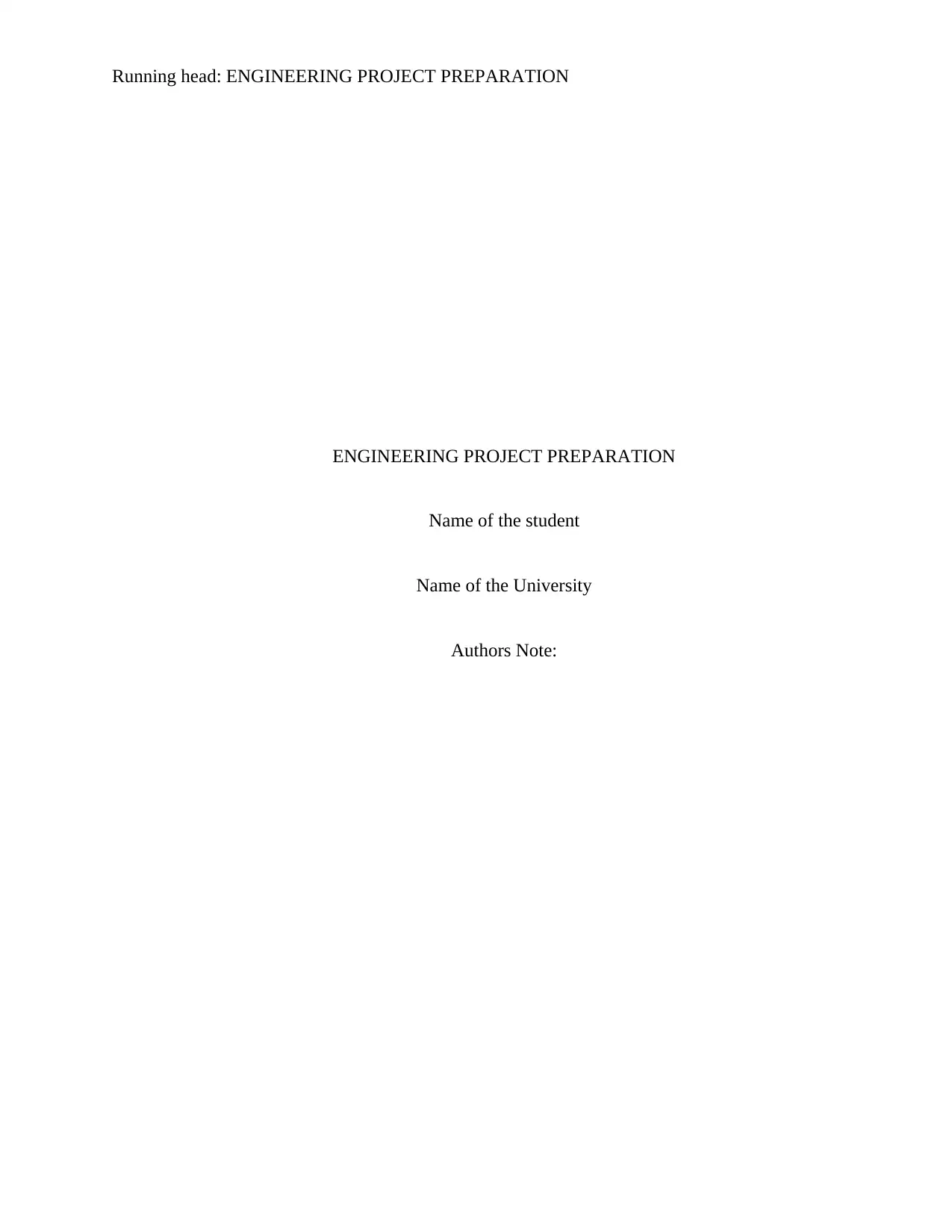
Running head: ENGINEERING PROJECT PREPARATION
ENGINEERING PROJECT PREPARATION
Name of the student
Name of the University
Authors Note:
ENGINEERING PROJECT PREPARATION
Name of the student
Name of the University
Authors Note:
Paraphrase This Document
Need a fresh take? Get an instant paraphrase of this document with our AI Paraphraser
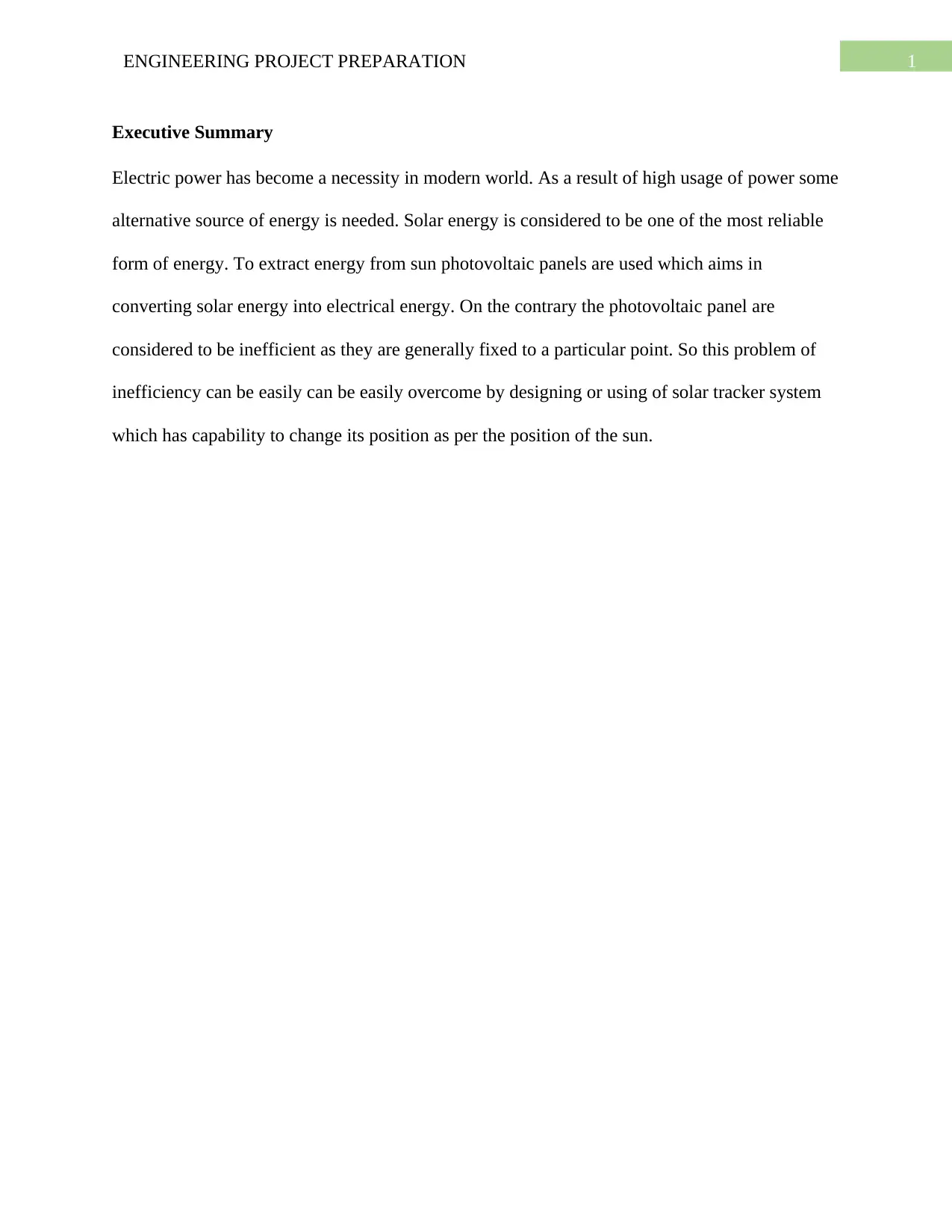
1ENGINEERING PROJECT PREPARATION
Executive Summary
Electric power has become a necessity in modern world. As a result of high usage of power some
alternative source of energy is needed. Solar energy is considered to be one of the most reliable
form of energy. To extract energy from sun photovoltaic panels are used which aims in
converting solar energy into electrical energy. On the contrary the photovoltaic panel are
considered to be inefficient as they are generally fixed to a particular point. So this problem of
inefficiency can be easily can be easily overcome by designing or using of solar tracker system
which has capability to change its position as per the position of the sun.
Executive Summary
Electric power has become a necessity in modern world. As a result of high usage of power some
alternative source of energy is needed. Solar energy is considered to be one of the most reliable
form of energy. To extract energy from sun photovoltaic panels are used which aims in
converting solar energy into electrical energy. On the contrary the photovoltaic panel are
considered to be inefficient as they are generally fixed to a particular point. So this problem of
inefficiency can be easily can be easily overcome by designing or using of solar tracker system
which has capability to change its position as per the position of the sun.

2ENGINEERING PROJECT PREPARATION
Table of Contents
Introduction..........................................................................................................................3
Discussion............................................................................................................................4
Literature Review............................................................................................................4
Research questions and project goals:.............................................................................4
Research questions:.........................................................................................................4
Aims of the project:.........................................................................................................5
Steps taken for the project:..............................................................................................5
Theoretical content:.........................................................................................................5
Experimental set-up:........................................................................................................6
Planning of project...........................................................................................................7
Gantt Chart.......................................................................................................................9
Conclusion.........................................................................................................................10
References..........................................................................................................................11
Table of Contents
Introduction..........................................................................................................................3
Discussion............................................................................................................................4
Literature Review............................................................................................................4
Research questions and project goals:.............................................................................4
Research questions:.........................................................................................................4
Aims of the project:.........................................................................................................5
Steps taken for the project:..............................................................................................5
Theoretical content:.........................................................................................................5
Experimental set-up:........................................................................................................6
Planning of project...........................................................................................................7
Gantt Chart.......................................................................................................................9
Conclusion.........................................................................................................................10
References..........................................................................................................................11
⊘ This is a preview!⊘
Do you want full access?
Subscribe today to unlock all pages.

Trusted by 1+ million students worldwide
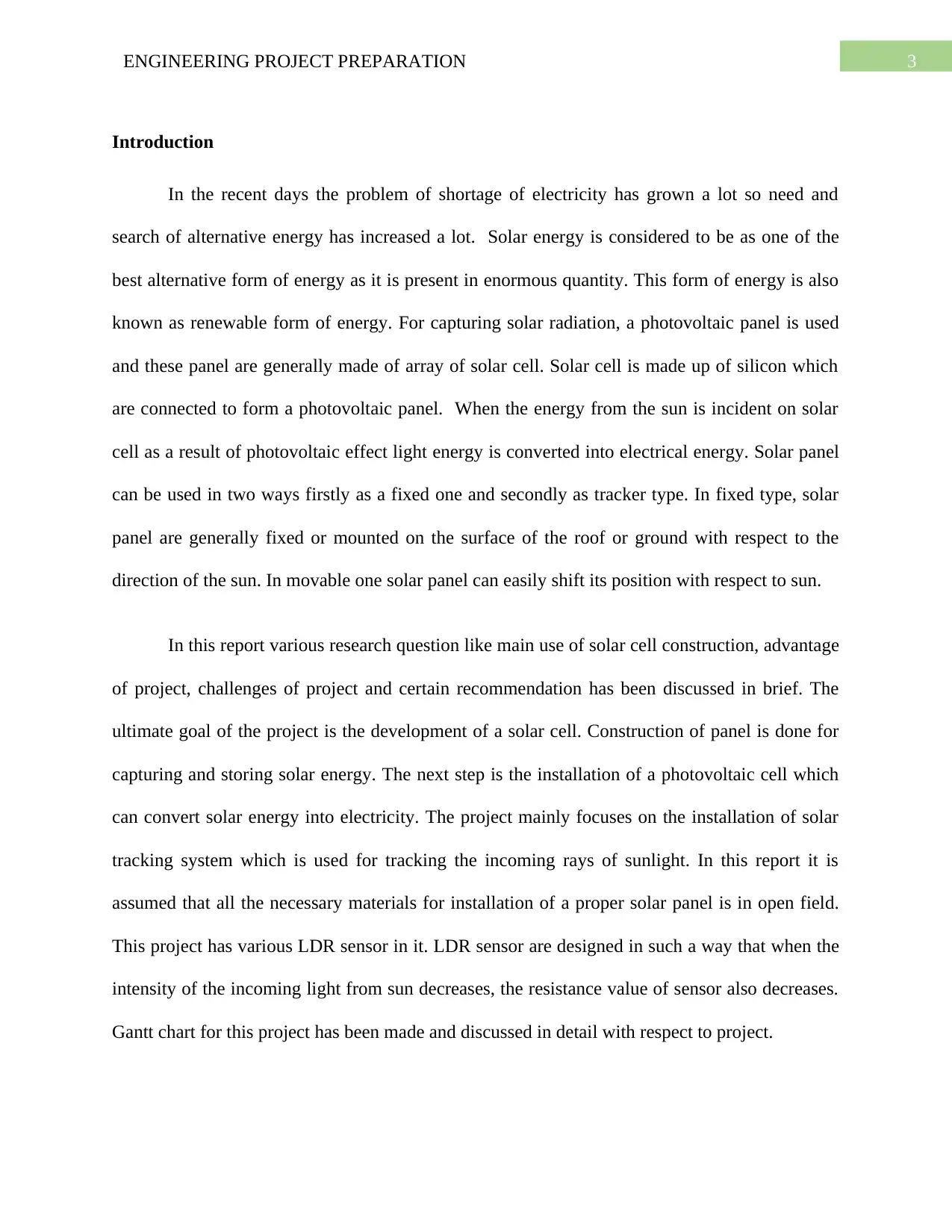
3ENGINEERING PROJECT PREPARATION
Introduction
In the recent days the problem of shortage of electricity has grown a lot so need and
search of alternative energy has increased a lot. Solar energy is considered to be as one of the
best alternative form of energy as it is present in enormous quantity. This form of energy is also
known as renewable form of energy. For capturing solar radiation, a photovoltaic panel is used
and these panel are generally made of array of solar cell. Solar cell is made up of silicon which
are connected to form a photovoltaic panel. When the energy from the sun is incident on solar
cell as a result of photovoltaic effect light energy is converted into electrical energy. Solar panel
can be used in two ways firstly as a fixed one and secondly as tracker type. In fixed type, solar
panel are generally fixed or mounted on the surface of the roof or ground with respect to the
direction of the sun. In movable one solar panel can easily shift its position with respect to sun.
In this report various research question like main use of solar cell construction, advantage
of project, challenges of project and certain recommendation has been discussed in brief. The
ultimate goal of the project is the development of a solar cell. Construction of panel is done for
capturing and storing solar energy. The next step is the installation of a photovoltaic cell which
can convert solar energy into electricity. The project mainly focuses on the installation of solar
tracking system which is used for tracking the incoming rays of sunlight. In this report it is
assumed that all the necessary materials for installation of a proper solar panel is in open field.
This project has various LDR sensor in it. LDR sensor are designed in such a way that when the
intensity of the incoming light from sun decreases, the resistance value of sensor also decreases.
Gantt chart for this project has been made and discussed in detail with respect to project.
Introduction
In the recent days the problem of shortage of electricity has grown a lot so need and
search of alternative energy has increased a lot. Solar energy is considered to be as one of the
best alternative form of energy as it is present in enormous quantity. This form of energy is also
known as renewable form of energy. For capturing solar radiation, a photovoltaic panel is used
and these panel are generally made of array of solar cell. Solar cell is made up of silicon which
are connected to form a photovoltaic panel. When the energy from the sun is incident on solar
cell as a result of photovoltaic effect light energy is converted into electrical energy. Solar panel
can be used in two ways firstly as a fixed one and secondly as tracker type. In fixed type, solar
panel are generally fixed or mounted on the surface of the roof or ground with respect to the
direction of the sun. In movable one solar panel can easily shift its position with respect to sun.
In this report various research question like main use of solar cell construction, advantage
of project, challenges of project and certain recommendation has been discussed in brief. The
ultimate goal of the project is the development of a solar cell. Construction of panel is done for
capturing and storing solar energy. The next step is the installation of a photovoltaic cell which
can convert solar energy into electricity. The project mainly focuses on the installation of solar
tracking system which is used for tracking the incoming rays of sunlight. In this report it is
assumed that all the necessary materials for installation of a proper solar panel is in open field.
This project has various LDR sensor in it. LDR sensor are designed in such a way that when the
intensity of the incoming light from sun decreases, the resistance value of sensor also decreases.
Gantt chart for this project has been made and discussed in detail with respect to project.
Paraphrase This Document
Need a fresh take? Get an instant paraphrase of this document with our AI Paraphraser
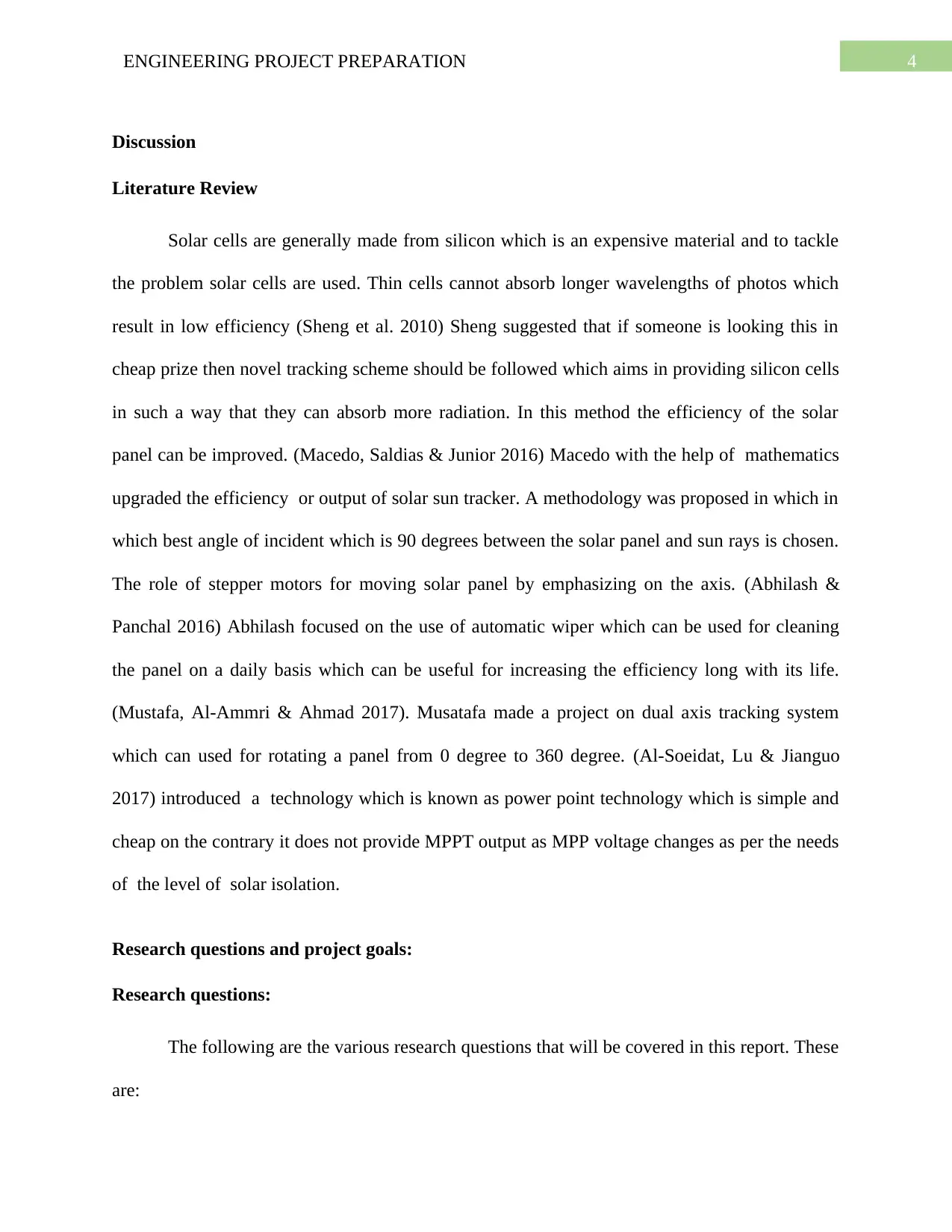
4ENGINEERING PROJECT PREPARATION
Discussion
Literature Review
Solar cells are generally made from silicon which is an expensive material and to tackle
the problem solar cells are used. Thin cells cannot absorb longer wavelengths of photos which
result in low efficiency (Sheng et al. 2010) Sheng suggested that if someone is looking this in
cheap prize then novel tracking scheme should be followed which aims in providing silicon cells
in such a way that they can absorb more radiation. In this method the efficiency of the solar
panel can be improved. (Macedo, Saldias & Junior 2016) Macedo with the help of mathematics
upgraded the efficiency or output of solar sun tracker. A methodology was proposed in which in
which best angle of incident which is 90 degrees between the solar panel and sun rays is chosen.
The role of stepper motors for moving solar panel by emphasizing on the axis. (Abhilash &
Panchal 2016) Abhilash focused on the use of automatic wiper which can be used for cleaning
the panel on a daily basis which can be useful for increasing the efficiency long with its life.
(Mustafa, Al-Ammri & Ahmad 2017). Musatafa made a project on dual axis tracking system
which can used for rotating a panel from 0 degree to 360 degree. (Al-Soeidat, Lu & Jianguo
2017) introduced a technology which is known as power point technology which is simple and
cheap on the contrary it does not provide MPPT output as MPP voltage changes as per the needs
of the level of solar isolation.
Research questions and project goals:
Research questions:
The following are the various research questions that will be covered in this report. These
are:
Discussion
Literature Review
Solar cells are generally made from silicon which is an expensive material and to tackle
the problem solar cells are used. Thin cells cannot absorb longer wavelengths of photos which
result in low efficiency (Sheng et al. 2010) Sheng suggested that if someone is looking this in
cheap prize then novel tracking scheme should be followed which aims in providing silicon cells
in such a way that they can absorb more radiation. In this method the efficiency of the solar
panel can be improved. (Macedo, Saldias & Junior 2016) Macedo with the help of mathematics
upgraded the efficiency or output of solar sun tracker. A methodology was proposed in which in
which best angle of incident which is 90 degrees between the solar panel and sun rays is chosen.
The role of stepper motors for moving solar panel by emphasizing on the axis. (Abhilash &
Panchal 2016) Abhilash focused on the use of automatic wiper which can be used for cleaning
the panel on a daily basis which can be useful for increasing the efficiency long with its life.
(Mustafa, Al-Ammri & Ahmad 2017). Musatafa made a project on dual axis tracking system
which can used for rotating a panel from 0 degree to 360 degree. (Al-Soeidat, Lu & Jianguo
2017) introduced a technology which is known as power point technology which is simple and
cheap on the contrary it does not provide MPPT output as MPP voltage changes as per the needs
of the level of solar isolation.
Research questions and project goals:
Research questions:
The following are the various research questions that will be covered in this report. These
are:
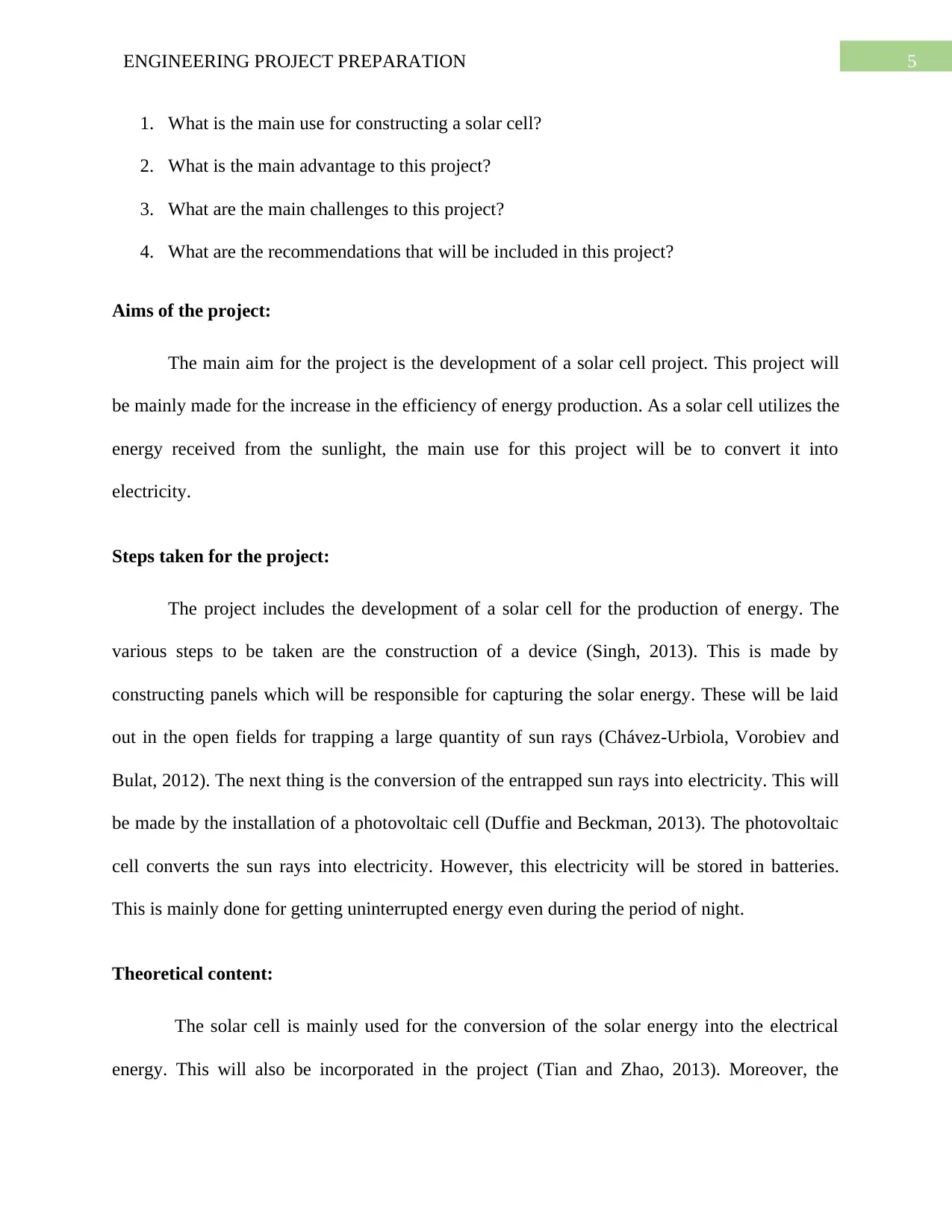
5ENGINEERING PROJECT PREPARATION
1. What is the main use for constructing a solar cell?
2. What is the main advantage to this project?
3. What are the main challenges to this project?
4. What are the recommendations that will be included in this project?
Aims of the project:
The main aim for the project is the development of a solar cell project. This project will
be mainly made for the increase in the efficiency of energy production. As a solar cell utilizes the
energy received from the sunlight, the main use for this project will be to convert it into
electricity.
Steps taken for the project:
The project includes the development of a solar cell for the production of energy. The
various steps to be taken are the construction of a device (Singh, 2013). This is made by
constructing panels which will be responsible for capturing the solar energy. These will be laid
out in the open fields for trapping a large quantity of sun rays (Chávez-Urbiola, Vorobiev and
Bulat, 2012). The next thing is the conversion of the entrapped sun rays into electricity. This will
be made by the installation of a photovoltaic cell (Duffie and Beckman, 2013). The photovoltaic
cell converts the sun rays into electricity. However, this electricity will be stored in batteries.
This is mainly done for getting uninterrupted energy even during the period of night.
Theoretical content:
The solar cell is mainly used for the conversion of the solar energy into the electrical
energy. This will also be incorporated in the project (Tian and Zhao, 2013). Moreover, the
1. What is the main use for constructing a solar cell?
2. What is the main advantage to this project?
3. What are the main challenges to this project?
4. What are the recommendations that will be included in this project?
Aims of the project:
The main aim for the project is the development of a solar cell project. This project will
be mainly made for the increase in the efficiency of energy production. As a solar cell utilizes the
energy received from the sunlight, the main use for this project will be to convert it into
electricity.
Steps taken for the project:
The project includes the development of a solar cell for the production of energy. The
various steps to be taken are the construction of a device (Singh, 2013). This is made by
constructing panels which will be responsible for capturing the solar energy. These will be laid
out in the open fields for trapping a large quantity of sun rays (Chávez-Urbiola, Vorobiev and
Bulat, 2012). The next thing is the conversion of the entrapped sun rays into electricity. This will
be made by the installation of a photovoltaic cell (Duffie and Beckman, 2013). The photovoltaic
cell converts the sun rays into electricity. However, this electricity will be stored in batteries.
This is mainly done for getting uninterrupted energy even during the period of night.
Theoretical content:
The solar cell is mainly used for the conversion of the solar energy into the electrical
energy. This will also be incorporated in the project (Tian and Zhao, 2013). Moreover, the
⊘ This is a preview!⊘
Do you want full access?
Subscribe today to unlock all pages.

Trusted by 1+ million students worldwide
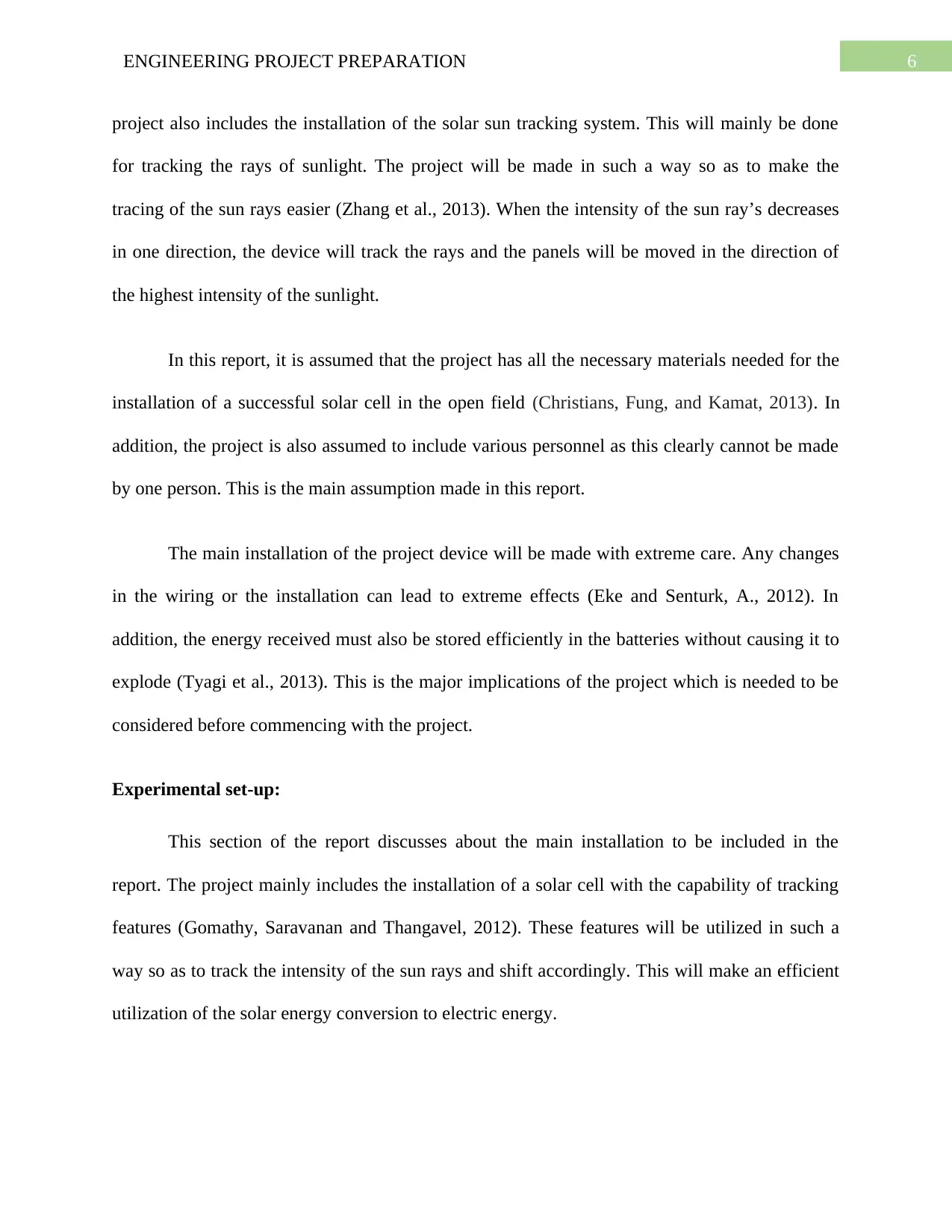
6ENGINEERING PROJECT PREPARATION
project also includes the installation of the solar sun tracking system. This will mainly be done
for tracking the rays of sunlight. The project will be made in such a way so as to make the
tracing of the sun rays easier (Zhang et al., 2013). When the intensity of the sun ray’s decreases
in one direction, the device will track the rays and the panels will be moved in the direction of
the highest intensity of the sunlight.
In this report, it is assumed that the project has all the necessary materials needed for the
installation of a successful solar cell in the open field (Christians, Fung, and Kamat, 2013). In
addition, the project is also assumed to include various personnel as this clearly cannot be made
by one person. This is the main assumption made in this report.
The main installation of the project device will be made with extreme care. Any changes
in the wiring or the installation can lead to extreme effects (Eke and Senturk, A., 2012). In
addition, the energy received must also be stored efficiently in the batteries without causing it to
explode (Tyagi et al., 2013). This is the major implications of the project which is needed to be
considered before commencing with the project.
Experimental set-up:
This section of the report discusses about the main installation to be included in the
report. The project mainly includes the installation of a solar cell with the capability of tracking
features (Gomathy, Saravanan and Thangavel, 2012). These features will be utilized in such a
way so as to track the intensity of the sun rays and shift accordingly. This will make an efficient
utilization of the solar energy conversion to electric energy.
project also includes the installation of the solar sun tracking system. This will mainly be done
for tracking the rays of sunlight. The project will be made in such a way so as to make the
tracing of the sun rays easier (Zhang et al., 2013). When the intensity of the sun ray’s decreases
in one direction, the device will track the rays and the panels will be moved in the direction of
the highest intensity of the sunlight.
In this report, it is assumed that the project has all the necessary materials needed for the
installation of a successful solar cell in the open field (Christians, Fung, and Kamat, 2013). In
addition, the project is also assumed to include various personnel as this clearly cannot be made
by one person. This is the main assumption made in this report.
The main installation of the project device will be made with extreme care. Any changes
in the wiring or the installation can lead to extreme effects (Eke and Senturk, A., 2012). In
addition, the energy received must also be stored efficiently in the batteries without causing it to
explode (Tyagi et al., 2013). This is the major implications of the project which is needed to be
considered before commencing with the project.
Experimental set-up:
This section of the report discusses about the main installation to be included in the
report. The project mainly includes the installation of a solar cell with the capability of tracking
features (Gomathy, Saravanan and Thangavel, 2012). These features will be utilized in such a
way so as to track the intensity of the sun rays and shift accordingly. This will make an efficient
utilization of the solar energy conversion to electric energy.
Paraphrase This Document
Need a fresh take? Get an instant paraphrase of this document with our AI Paraphraser
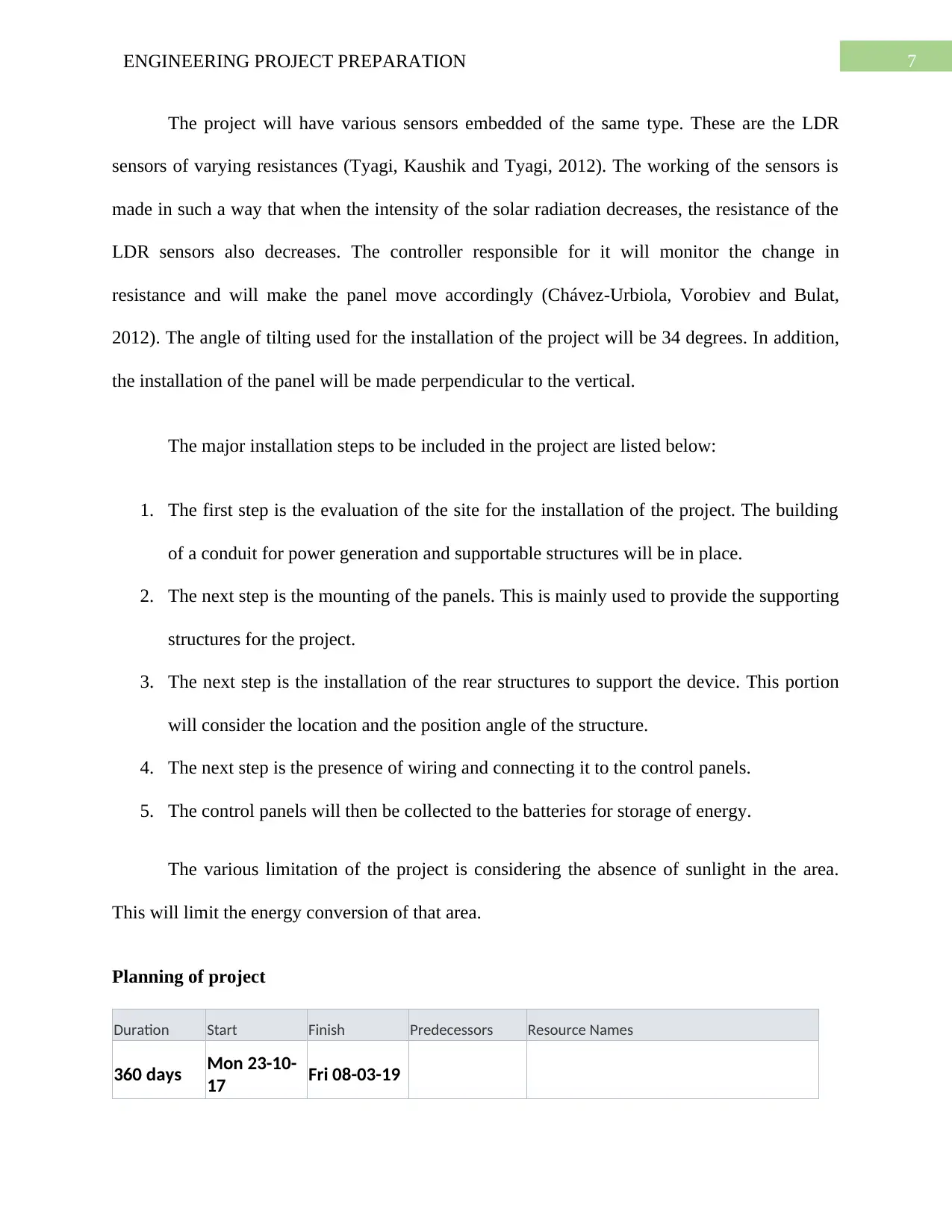
7ENGINEERING PROJECT PREPARATION
The project will have various sensors embedded of the same type. These are the LDR
sensors of varying resistances (Tyagi, Kaushik and Tyagi, 2012). The working of the sensors is
made in such a way that when the intensity of the solar radiation decreases, the resistance of the
LDR sensors also decreases. The controller responsible for it will monitor the change in
resistance and will make the panel move accordingly (Chávez-Urbiola, Vorobiev and Bulat,
2012). The angle of tilting used for the installation of the project will be 34 degrees. In addition,
the installation of the panel will be made perpendicular to the vertical.
The major installation steps to be included in the project are listed below:
1. The first step is the evaluation of the site for the installation of the project. The building
of a conduit for power generation and supportable structures will be in place.
2. The next step is the mounting of the panels. This is mainly used to provide the supporting
structures for the project.
3. The next step is the installation of the rear structures to support the device. This portion
will consider the location and the position angle of the structure.
4. The next step is the presence of wiring and connecting it to the control panels.
5. The control panels will then be collected to the batteries for storage of energy.
The various limitation of the project is considering the absence of sunlight in the area.
This will limit the energy conversion of that area.
Planning of project
Duration Start Finish Predecessors Resource Names
360 days Mon 23-10-
17 Fri 08-03-19
The project will have various sensors embedded of the same type. These are the LDR
sensors of varying resistances (Tyagi, Kaushik and Tyagi, 2012). The working of the sensors is
made in such a way that when the intensity of the solar radiation decreases, the resistance of the
LDR sensors also decreases. The controller responsible for it will monitor the change in
resistance and will make the panel move accordingly (Chávez-Urbiola, Vorobiev and Bulat,
2012). The angle of tilting used for the installation of the project will be 34 degrees. In addition,
the installation of the panel will be made perpendicular to the vertical.
The major installation steps to be included in the project are listed below:
1. The first step is the evaluation of the site for the installation of the project. The building
of a conduit for power generation and supportable structures will be in place.
2. The next step is the mounting of the panels. This is mainly used to provide the supporting
structures for the project.
3. The next step is the installation of the rear structures to support the device. This portion
will consider the location and the position angle of the structure.
4. The next step is the presence of wiring and connecting it to the control panels.
5. The control panels will then be collected to the batteries for storage of energy.
The various limitation of the project is considering the absence of sunlight in the area.
This will limit the energy conversion of that area.
Planning of project
Duration Start Finish Predecessors Resource Names
360 days Mon 23-10-
17 Fri 08-03-19

8ENGINEERING PROJECT PREPARATION
20 days Mon 23-10-
17 Fri 17-11-17
4 days Mon 23-10-17 Thu 26-10-17
4 days Fri 27-10-17 Wed 01-11-17 2
4 days Thu 02-11-17 Tue 07-11-17 3
4 days Wed 08-11-
17 Mon 13-11-17 4
4 days Tue 14-11-17 Fri 17-11-17 5
60 days Mon 20-11-
17 Fri 09-02-18
15 days Mon 20-11-17 Fri 08-12-17 6
15 days Mon 11-12-17 Fri 29-12-17 8
20 days Mon 01-01-18 Fri 26-01-18 9
10 days Mon 29-01-18 Fri 09-02-18 10
260 days Mon 12-02-
18 Fri 08-02-19
30 days Mon 12-02-18 Fri 23-03-18 11
10 days Mon 26-03-18 Fri 06-04-18 13
10 days Mon 09-04-18 Fri 20-04-18 14
5 days Mon 23-04-18 Fri 27-04-18 15
150 days Mon 30-04-18 Fri 23-11-18 16
15 days Mon 26-11-18 Fri 14-12-18 17
30 days Mon 17-12-18 Fri 25-01-19 18
10 days Mon 28-01-19 Fri 08-02-19 19
20 days Mon 11-02-
19 Fri 08-03-19
10 days Mon 11-02-19 Fri 22-02-19 20
10 days Mon 25-02-19 Fri 08-03-19 22
20 days Mon 23-10-
17 Fri 17-11-17
4 days Mon 23-10-17 Thu 26-10-17
4 days Fri 27-10-17 Wed 01-11-17 2
4 days Thu 02-11-17 Tue 07-11-17 3
4 days Wed 08-11-
17 Mon 13-11-17 4
4 days Tue 14-11-17 Fri 17-11-17 5
60 days Mon 20-11-
17 Fri 09-02-18
15 days Mon 20-11-17 Fri 08-12-17 6
15 days Mon 11-12-17 Fri 29-12-17 8
20 days Mon 01-01-18 Fri 26-01-18 9
10 days Mon 29-01-18 Fri 09-02-18 10
260 days Mon 12-02-
18 Fri 08-02-19
30 days Mon 12-02-18 Fri 23-03-18 11
10 days Mon 26-03-18 Fri 06-04-18 13
10 days Mon 09-04-18 Fri 20-04-18 14
5 days Mon 23-04-18 Fri 27-04-18 15
150 days Mon 30-04-18 Fri 23-11-18 16
15 days Mon 26-11-18 Fri 14-12-18 17
30 days Mon 17-12-18 Fri 25-01-19 18
10 days Mon 28-01-19 Fri 08-02-19 19
20 days Mon 11-02-
19 Fri 08-03-19
10 days Mon 11-02-19 Fri 22-02-19 20
10 days Mon 25-02-19 Fri 08-03-19 22
⊘ This is a preview!⊘
Do you want full access?
Subscribe today to unlock all pages.

Trusted by 1+ million students worldwide
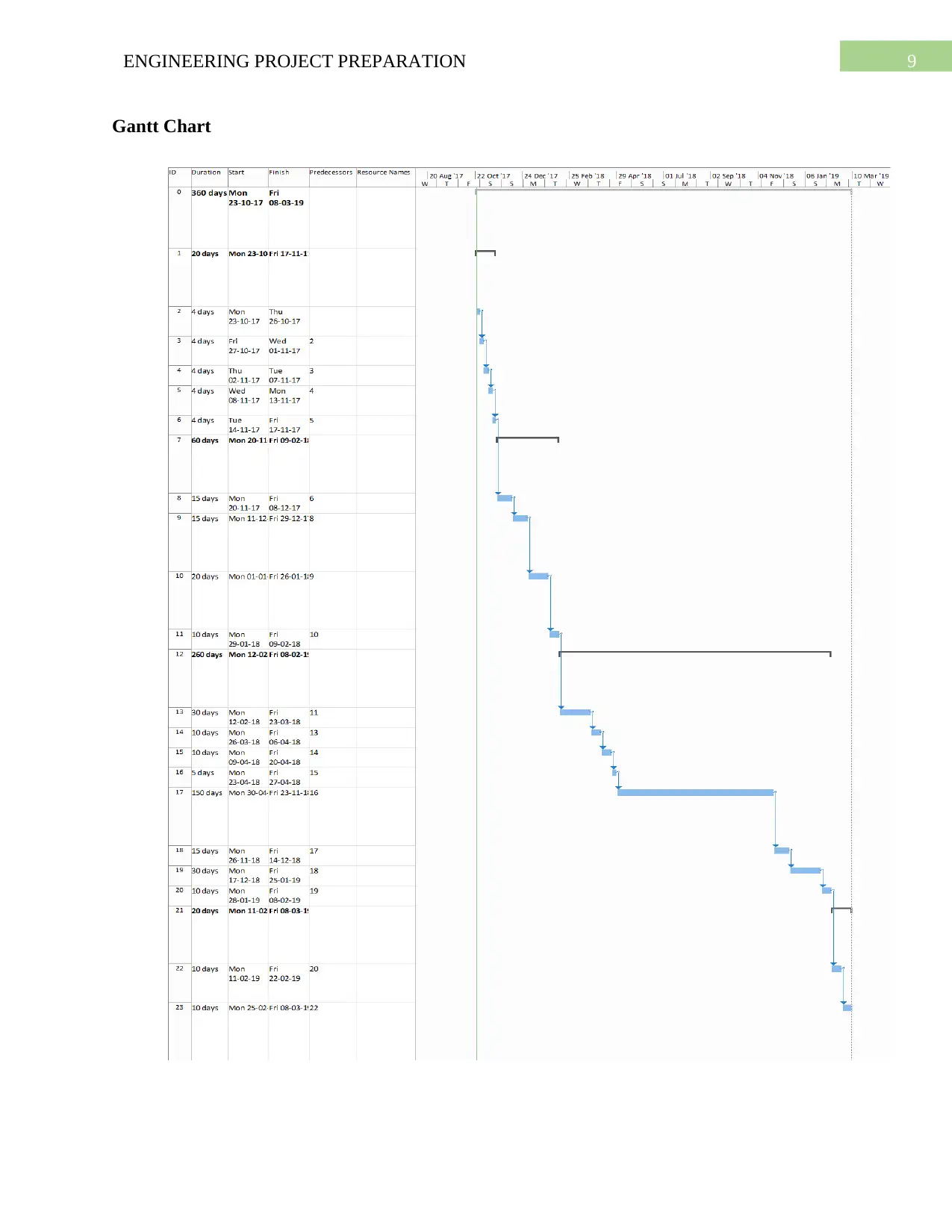
9ENGINEERING PROJECT PREPARATION
Gantt Chart
Gantt Chart
Paraphrase This Document
Need a fresh take? Get an instant paraphrase of this document with our AI Paraphraser
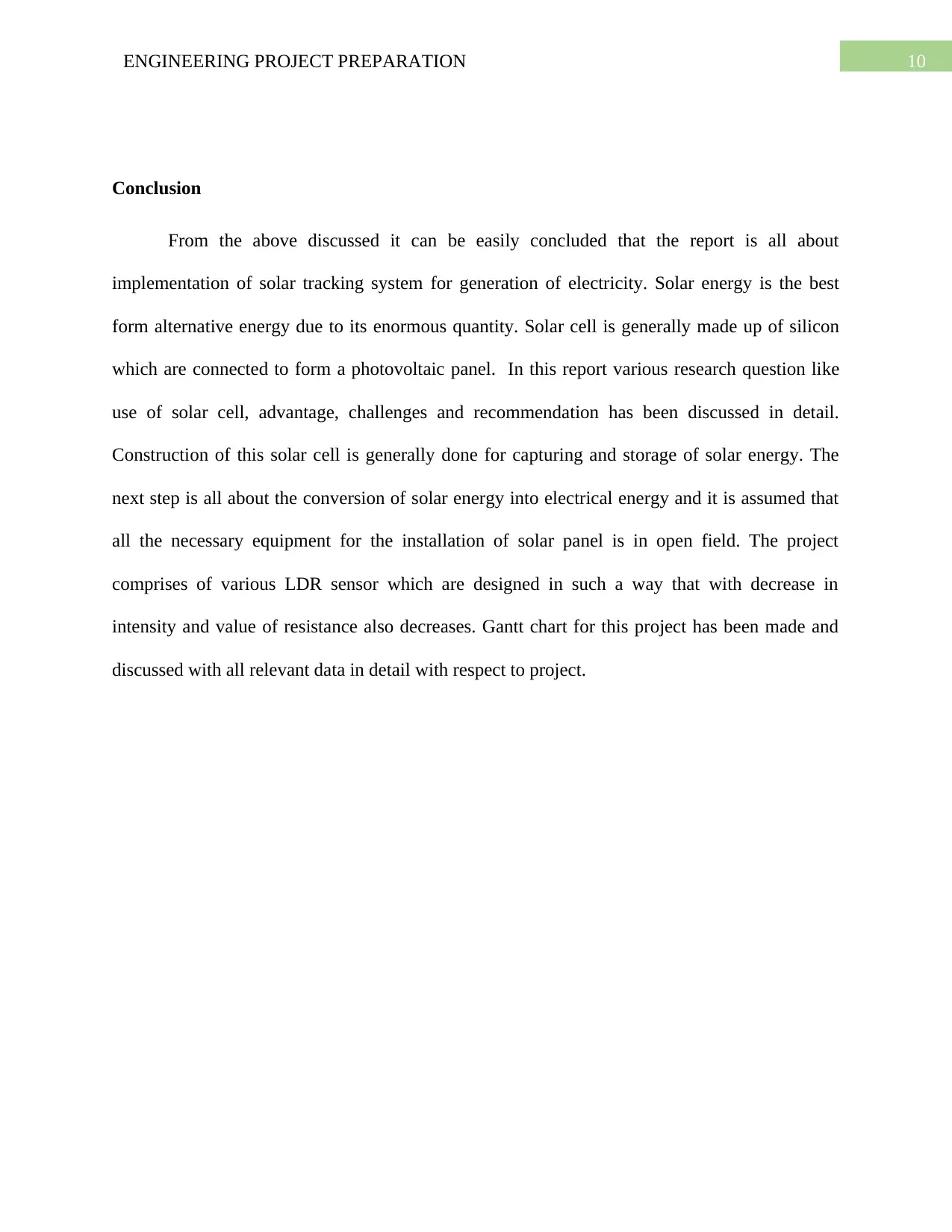
10ENGINEERING PROJECT PREPARATION
Conclusion
From the above discussed it can be easily concluded that the report is all about
implementation of solar tracking system for generation of electricity. Solar energy is the best
form alternative energy due to its enormous quantity. Solar cell is generally made up of silicon
which are connected to form a photovoltaic panel. In this report various research question like
use of solar cell, advantage, challenges and recommendation has been discussed in detail.
Construction of this solar cell is generally done for capturing and storage of solar energy. The
next step is all about the conversion of solar energy into electrical energy and it is assumed that
all the necessary equipment for the installation of solar panel is in open field. The project
comprises of various LDR sensor which are designed in such a way that with decrease in
intensity and value of resistance also decreases. Gantt chart for this project has been made and
discussed with all relevant data in detail with respect to project.
Conclusion
From the above discussed it can be easily concluded that the report is all about
implementation of solar tracking system for generation of electricity. Solar energy is the best
form alternative energy due to its enormous quantity. Solar cell is generally made up of silicon
which are connected to form a photovoltaic panel. In this report various research question like
use of solar cell, advantage, challenges and recommendation has been discussed in detail.
Construction of this solar cell is generally done for capturing and storage of solar energy. The
next step is all about the conversion of solar energy into electrical energy and it is assumed that
all the necessary equipment for the installation of solar panel is in open field. The project
comprises of various LDR sensor which are designed in such a way that with decrease in
intensity and value of resistance also decreases. Gantt chart for this project has been made and
discussed with all relevant data in detail with respect to project.
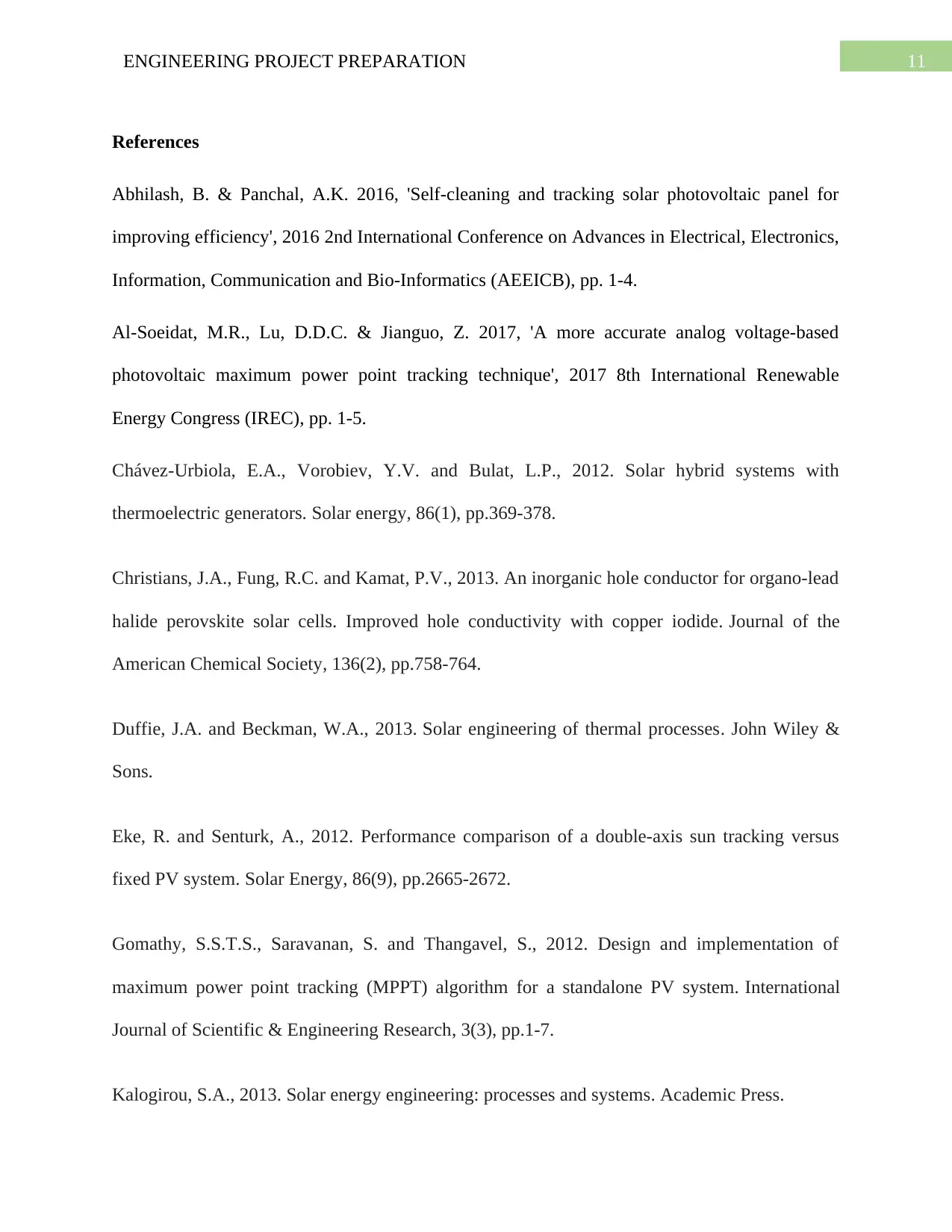
11ENGINEERING PROJECT PREPARATION
References
Abhilash, B. & Panchal, A.K. 2016, 'Self-cleaning and tracking solar photovoltaic panel for
improving efficiency', 2016 2nd International Conference on Advances in Electrical, Electronics,
Information, Communication and Bio-Informatics (AEEICB), pp. 1-4.
Al-Soeidat, M.R., Lu, D.D.C. & Jianguo, Z. 2017, 'A more accurate analog voltage-based
photovoltaic maximum power point tracking technique', 2017 8th International Renewable
Energy Congress (IREC), pp. 1-5.
Chávez-Urbiola, E.A., Vorobiev, Y.V. and Bulat, L.P., 2012. Solar hybrid systems with
thermoelectric generators. Solar energy, 86(1), pp.369-378.
Christians, J.A., Fung, R.C. and Kamat, P.V., 2013. An inorganic hole conductor for organo-lead
halide perovskite solar cells. Improved hole conductivity with copper iodide. Journal of the
American Chemical Society, 136(2), pp.758-764.
Duffie, J.A. and Beckman, W.A., 2013. Solar engineering of thermal processes. John Wiley &
Sons.
Eke, R. and Senturk, A., 2012. Performance comparison of a double-axis sun tracking versus
fixed PV system. Solar Energy, 86(9), pp.2665-2672.
Gomathy, S.S.T.S., Saravanan, S. and Thangavel, S., 2012. Design and implementation of
maximum power point tracking (MPPT) algorithm for a standalone PV system. International
Journal of Scientific & Engineering Research, 3(3), pp.1-7.
Kalogirou, S.A., 2013. Solar energy engineering: processes and systems. Academic Press.
References
Abhilash, B. & Panchal, A.K. 2016, 'Self-cleaning and tracking solar photovoltaic panel for
improving efficiency', 2016 2nd International Conference on Advances in Electrical, Electronics,
Information, Communication and Bio-Informatics (AEEICB), pp. 1-4.
Al-Soeidat, M.R., Lu, D.D.C. & Jianguo, Z. 2017, 'A more accurate analog voltage-based
photovoltaic maximum power point tracking technique', 2017 8th International Renewable
Energy Congress (IREC), pp. 1-5.
Chávez-Urbiola, E.A., Vorobiev, Y.V. and Bulat, L.P., 2012. Solar hybrid systems with
thermoelectric generators. Solar energy, 86(1), pp.369-378.
Christians, J.A., Fung, R.C. and Kamat, P.V., 2013. An inorganic hole conductor for organo-lead
halide perovskite solar cells. Improved hole conductivity with copper iodide. Journal of the
American Chemical Society, 136(2), pp.758-764.
Duffie, J.A. and Beckman, W.A., 2013. Solar engineering of thermal processes. John Wiley &
Sons.
Eke, R. and Senturk, A., 2012. Performance comparison of a double-axis sun tracking versus
fixed PV system. Solar Energy, 86(9), pp.2665-2672.
Gomathy, S.S.T.S., Saravanan, S. and Thangavel, S., 2012. Design and implementation of
maximum power point tracking (MPPT) algorithm for a standalone PV system. International
Journal of Scientific & Engineering Research, 3(3), pp.1-7.
Kalogirou, S.A., 2013. Solar energy engineering: processes and systems. Academic Press.
⊘ This is a preview!⊘
Do you want full access?
Subscribe today to unlock all pages.

Trusted by 1+ million students worldwide
1 out of 14
Related Documents
Your All-in-One AI-Powered Toolkit for Academic Success.
+13062052269
info@desklib.com
Available 24*7 on WhatsApp / Email
![[object Object]](/_next/static/media/star-bottom.7253800d.svg)
Unlock your academic potential
Copyright © 2020–2025 A2Z Services. All Rights Reserved. Developed and managed by ZUCOL.



